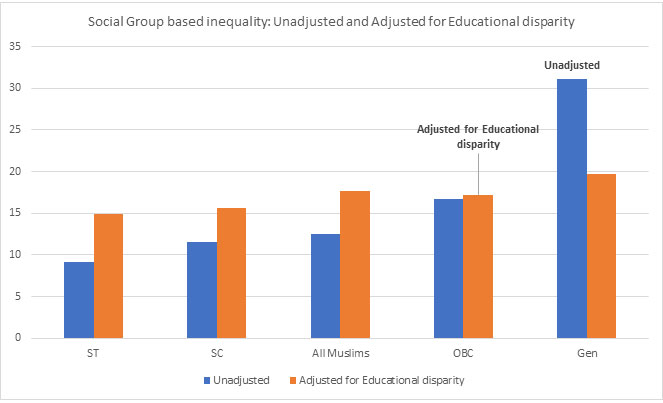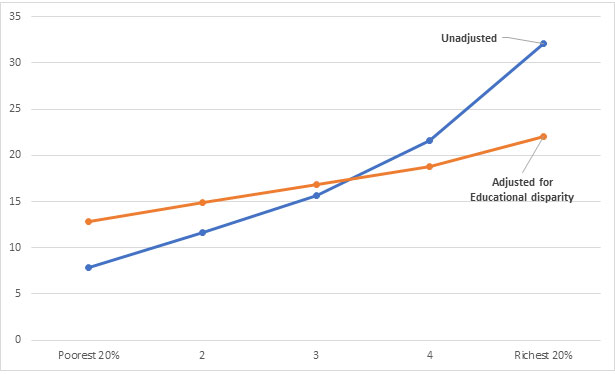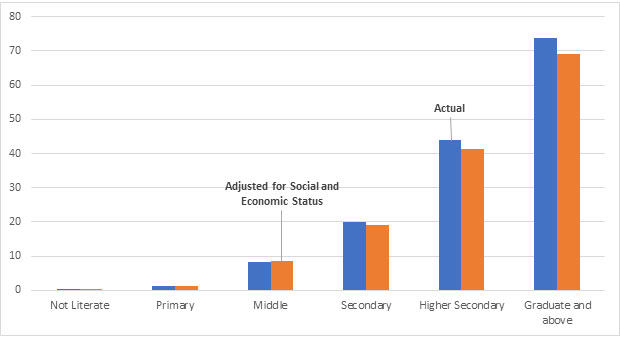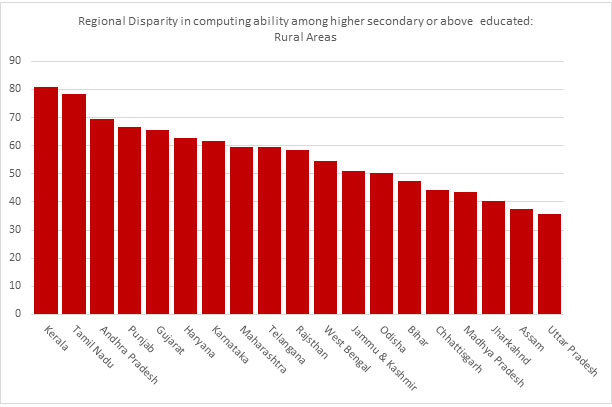On account of the Covid-19 pandemic, most educational institutions in India have adopted online teaching as a solution to offset huge deficits in instruction hours. However, citizens who do not have digital capabilities or ownership of computing devices, are suffering the most in these challenging times. Siddiqui and Ahamed analyse National Sample Survey data, and argue that the disparity in access to education is at the root of the digital divide across socioeconomic groups.
Covid-19 pandemic has caused an unprecedented and sustained disruption in every sphere of life, including education and pedagogy. Skilled and educated workers in the economy immediately transitioned into working digitally, with some level of efficacy. The poor and unskilled, however, simply lost their jobs. Educational institutions around the world, backed by their governments, have adopted online teaching as a solution to compensate for huge deficits in instruction hours. In India, most public and private educational institutions, including the University Grants Commission (UGC), have followed the same path. However, they seem to be imitating the developed countries without a nuanced understanding of their own ground reality. Without tackling educational disparity, the digital divide cannot be addressed. Educated India is a prerequisite for ‘Digital India’. Unfortunately, several studies and a national-level survey show that the quality of learning at primary and secondary level has been declining (ASER (Annual Status of Education Report) Centre, 2015; Das and Biswas 2019).
The country’s leadership – despite setbacks and contrary evidences – believes that information technology (IT) will provide solutions for most of India’s development problems. This approach of a ‘technological fix’ to an extraordinary humanitarian crisis, including provision of education and health services through digital platforms, is likely to widen the inequality in accessing them. The citizens in the ‘offline’ category will suffer the most in the changing and challenging times. Successive governments in India, particularly the present one, have pushed for IT-enabled platforms to provide public services without equipping the population with digital capabilities in a commensurate manner. Instead of ensuring accountability in providing access to education and health, institutions of governance continue to spend resources on implementing IT-based tools originally intended to prevent wrongful inclusion or leakage in publicly funded programmes, such as the PDS (public distribution system) and MNREGA (Mahatma Gandhi National Rural Employment Guarantee Act), but in the process, inadvertently delaying or preventing the programmes’ benefits from reaching those who are genuinely eligible, as they lack ‘computing ability’. Studies also illustrate that there is no improvement in transparency or accountability in these services’ delivery after the introduction of IT-based tools (Khera and Patibandla 2020, Vivek et al. 2018, Masiero 2015).
The moot question is what comes first: digital advancement, or the advancement of human capability? As political commentator Nissim Mannathukkaren (2015) aptly highlighted, “What should worry us is not the digital divide, but the fundamental divide between a rapidly growing technological capability and a snail-like growth in eliminating human deprivation.” A person can develop technological capability with a good quality of education. A person with higher education is more likely than a person with a few years of schooling to utilise the benefits of digital technology.
What do the data show about Indian households’ digital capabilities?
We need a reality check to understand Indians’ ability to use online platforms to access government-funded social protection programmes, and educational instruction during the Covid-19 pandemic. Latest available data from the National Sample Survey (NSS) conducted in 2017-18, on ‘Household Social Consumption on Education in India’ reveal the hollowness of such a policy approach.
The Survey collected information regarding the availability of computing devices and the internet in households. It also tried to find out how many individuals could use computers (smartphones included) and the internet. A person is considered as having computing ability if he is capable of using both of these computing devices as well as the internet.
The Survey finds that the ownership of computing devices is abysmally low in India. Only one out of over 10 (10.7) households possess a computing device, which includes devices such as desktop, laptop, notebook, palmtop, and tablet. The rural-urban disparity in computing-device ownership is quite stark. In rural areas, Schedule Tribes (STs) are at the bottom of 2.47% of households who owned any computing device, followed by Scheduled Castes (SCs) (3.27%), and Muslims (3.58%). In urban areas, Muslims and SCs are the worst-off groups when it comes to computing-device ownership (12.7%) while STs and Other Backward Classes (OBCs) are slightly better (over 19%).
Over the last decade, with the entry of multiple internet-service providers, internet subscribers have increased dramatically – from 267.4 million in December 2014 to 687.2 million in September 2019. As a result of increased competition among internet service providers, the internet is more affordable than ever before. In rural India, less than 15% of the households have internet facility; however, for ST households, the number is as low as 9%. Notwithstanding the disparity across social groups, urban households are well-placed with 42% having access to the internet in 2018-19.
Disparity in access to education and the digital divide
Our analysis of the Survey data indicates that only about 11% of rural and 40% of the urban population above 14 years of age can operate a computer as well as use the internet. It is difficult to imagine the use of digital platforms by such poorly equipped communities to access public services. Further, the existing stock of digital capabilities remains limited even among upper socioeconomic strata.
According to the analysis, the disparity in access to education is at the root of the digital divide. ‘Computing ability’ is inextricably linked to the educational attainment of individuals. The social group or economic status-based gap that we see are mainly because educational attainment itself is graded on the basis of socioeconomic status. Once we look at a scenario that is adjusted for the disparity in educational attainment, social group based disparity in computing ability nearly disappears, and economic status-based disparity gets moderated significantly (Figures 1 and 2).
Figure 1. Share (%) of above-14 population equipped with computing ability, across social groups

Note: Unadjusted bars (blue) reflect the actual fraction of population with computing ability, while adjusted bars (orange) reflect a hypothetical scenario if there were no educational disparity across social groups.
Figure 2. Share (%) of above-14 population equipped with computing ability, across economic groups

Note: Blue line represents the actual share of population with computing ability across respective economic groups, while the orange line represents a hypothetical scenario if there were no educational disparity by economic status.
Even the gender-based digital divide can largely be explained by the corresponding gender-based disparity in educational achievements. Thus, social and economic hierarchies in digital abilities are a mirror image of the educational inequality across different economic and social groups. Figure 3 corroborates this in an alternative manner, by displaying disparity in computing ability by the level of educational attainment – actual, as well as after adjusting for social and economic status-based inequality that may exist in educational attainment. The fact that education-based disparity in computing ability remains at a similar level even after adjusting for socioeconomic disparity reinforces the importance of education as a prerequisite for broad-based development of digital capability in the population.
Figure 3. Share (%) of above-14 population equipped with computing ability, by maximum level of education attained

Note: Blue bars represent the actual share of population with computing ability for the respective education level, while orange bars represent a hypothetical scenario if there were no educational disparity by social and economic status.
The digital divide is bound to intensify the pre-existing learning divide between rich and poor households due to closure of classroom teaching for this extended period. Children belonging to affluent and educated households have all the necessary support for learning, as parents themselves are capable of imparting education, and they can also access online teaching. However, children of poor and uneducated parents who mostly go to government schools and have no digital capabilities are left in limbo. Television-based virtual classes are welcome, but the fact that kids are delinked from their own teachers reduces their motivation and sense of responsibility in completing the tasks.
This is particularly the case for government schools and budget private schools. Addressing the need for quality education for the bottom-half of the population should be the primary strategy for achievement of Digital India. Access to quality education has become an increasingly important issue as language and arithmetic ability of students have been experiencing a secular decline in for many years now (Agarwal and Bandyopadhyay 2018).
Data on computing ability show a disturbing regional disparity even among educated individuals. Educated individuals in South India are more likely to be equipped with computing ability. Figure 4 shows that less than 36% of individuals who have completed higher secondary or above education in Uttar Pradesh were equipped in computing ability. In comparison, in Kerala, close to 81% of individuals with the same level of education could use computing devices and the internet. This regional disparity in computing facility once again hints towards concomitant regional disparity in the provision of quality education in India and the lack of adaptation to English in the Hindi heartland, that is, the Indo-Gangetic belt and Central India. Since accessing a digital device such as a computer requires a minimum level of English language skill, e-governance or ICT-enabled platforms, usually available in regional language alternatives, may be of little help to those who do not have a minimum working knowledge of English.
Figure 4. Share (%) of above-14 year population with higher secondary and above education equipped with computing ability, across Indian states
Concluding remarks
Without doubt, there has been a massive proliferation of computing devices and internet connections in India since low-cost digital devices and cheap internet flooded the Indian market. Yet, it significantly differs from what we need for digital India, that is, computing ability. We need to understand the subtle difference between the ability to forward messages on WhatsApp and to fill out an online application form, with documents attached, through a digital device. The latter entails a set of technical skills, such as installing apps, browsing websites, scanning documents, and successfully attaching documents of required size and resolution.
The goal of Digital India will remain elusive unless the constitutional commitments of ensuring quality education for all, are fulfilled. The government must shun the deeply flawed ‘technological approach’ to eliminate human suffering, and instead, adopt a humanist approach to tackle deprivation, including the provision of quality education through public deliberation, systematic investment, and enhanced accountability.
Further Reading
- Agarwal, A and S Bandyopadhyay (2018), ‘India’s education quandary: Learning from learning outcomes’, Ideas for India, 10 December 2018.
- ASER Centre (2015), ‘Trends Over Time 2006-14: A supplement to ASER 2014’, New Delhi.
- Basu, K (2016), ‘India’s digital Transformation’, The Hindu, 12 February 2016.
- Das, S and AK Biswas (2019), ‘Quality and Determinants of Primary Education in Rural India’, 13 May 2019.
- Khera, Reetika and Vineeth Patibandla (2020), “Information Technology (IT) and Welfare in India: Does IT work?”, COMPASS ’20: Proceedings of the 3rd ACM SIGCAS Conference on Computing and Sustainable Societies, 284-285.
- Mannathukkaren, N (2015), ‘The grand delusion of Digital India’, 6 October 2015.
- Masiero, Silvia (2015), “Redesigning the Indian food security system through e-governance: The case of Kerala”, World Development, 67:126-137.
- Ministry of Statistics and Programme Implementation (2019), ‘Unit Level data & Report on NSS 75th Round for Schedule- 25.2 (July 2017-June 2018), Social Consumption: Education’, Government of India.
- Sreekumar, TT (2011), ICTs and development in India: Perspectives on the rural network society, Anthem Press.
- Thomas, Jayan and Govindan Parayil (2008), “Bridging the Social and Digital Divides in Andhra Pradesh and Kerala: A Capabilities Approach”, Development and Change, 39(3):409-435.
- Vivek, S, Rajendran Narayanan, Dipanjan Chakraborty, Rajesh Veeraraghavan and Vibhore Vardhan (2018), “Are Technology-enabled Cash Transfers Really ‘Direct’”, Economic and Political Weekly, 53(30).
- Zyskowski, K (2018), ‘'Digital India’, a double-edged sword’, Hindu Business Line, 11 January 2018.




 09 July, 2020
09 July, 2020 






By: Shubham Sahai 09 July, 2020
Brilliant article. I really appreciated the part that emphasizes placing importance to human ability in addition to addressing the digital capability divide. It would be wrong to assume Digital India as being the panacea - one size fits all solution to India's development related problems. I think for Digital India with its good intentions for the well being of the entire population to work, as part of the policy framework to bridge the human ability gap to provide tangible benefits to India, we first and foremost need to nurture the human capabilities across the various ethnic, socio-economic groups. The corporate sector does recognize the growing importance of rural India and its immense potential for growth in terms of digital enhancement. This realization would ultimately result in the holistic upliftment of the masses only if their "human abilities" are also similarly nurtured, as it is studies indicate that with half a billion active users, Indian internet is more rural, local, mobile-first than ever. So an opportunity beckons the government to leverage Digital India along with the skill enhancement of the masses, investing in rural education to help boost human capabilities across various socio economic groups thereby leading to the overall development of India which Digital India ultimately aims for, while bridging the digital capability divide.